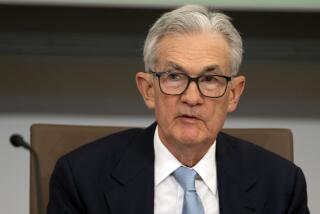Party Can’t Go on Forever, Greenspan Says
- Share via
WASHINGTON — While labeling U.S. economic growth in the 1990s “truly phenomenal,” Federal Reserve Chairman Alan Greenspan cautioned Thursday that the good times cannot last forever. His remarks rattled bond investors, who bid up market interest rates.
In a Chicago speech, Greenspan warned that the big gains in productivity driving the economy’s boom may not be enough to keep up with the steadily rising demand for workers and the shrinking pool of new people to take the additional jobs.
He also cited such potential growth-inhibiting problems as the rising trade deficit, continued over-enthusiasm among investors and a still-fragile world economy.
“There are imbalances in our expansion that, unless redressed, will bring this long run of strong growth and low inflation to a close,” he warned.
On inflation, he said: “At some point, labor market conditions can become so tight that the rise in nominal wages will start increasingly outpacing the gains in labor productivity, and prices inevitably will then begin to accelerate.”
That’s precisely what bondholders did not want to hear, and the yield on the 30-year Treasury bond--a benchmark for other long-term rates, such as for mortgages--jumped from 5.70% on Wednesday to 5.79% on Thursday, highest since last June 4. But the stock market’s reaction was muted.
Analysts doubted that Greenspan’s remarks signaled any immediate plan by the Fed to raise the short-term rates directly under its control. But they said the central banker’s comments were distinctly more cautionary than his recent previous statements about the economy, and boosted odds of a Fed rate hike later in the year.
“What he was doing was reminding people there are speed limits to how fast this economy can grow, and that at some point those limits are going to kick in,” said Richard B. Berner, chief U.S. economist with Morgan Stanley Dean Witter in New York.
Greenspan’s remarks came less than two weeks before the next meeting of the Federal Open Market Committee, the central bank’s rate-policy board. Greenspan has made a point in recent years of telegraphing the central bank’s views in advance of any big policy shift in order to avoid surprising the sky-high financial markets.
Thursday’s comments raised anxiety over statistics due out today reporting the nation’s unemployment, job growth and average hourly earnings figures for April.
Analysts estimate that joblessness remained at a 29-year low of 4.2%, that the economy added about 250,000 jobs and that earnings rose by a few tenths of a percent. They warned that if any of the numbers come in stronger than expected, investors would probably interpret the news as a sign that inflation was resurgent, and the stock and bond markets could plunge.
“If earnings and job growth are tranquil, the markets will shrug off the numbers. If they’re not, they’ll be upset,” said Lyle E. Gramley, a former Fed governor who is now a consultant with the Mortgage Bankers Assn. in Washington.
Analysts said Greenspan’s warnings revealed as much about his own methods as about the condition of the nation’s economy. He only recently persuaded some of his central bank colleagues to adopt what had been his sunny view of the economy. But no sooner did he succeed than he apparently began to worry again.
“This is classic Greenspan,” said David M. Jones, vice chairman of the New York bond house Aubrey G. Lanston & Co. “Central bankers are paid to worry, not to be satisfied with what they have accomplished.”
As he has in the past, Greenspan took a few shots at the stock market, suggesting that the “spectacular rise in equity prices . . . has reached well beyond the justifiable.”
But he devoted most of his remarks to the “benevolent but bedeviling question of how the American economy . . . has managed to remain an oasis of prosperity” in contrast to most of the rest of the world. His answer: rising productivity.
As he has before, Greenspan traced much of the improvement to advances in high technology that he said have raised productivity growth from an anemic 1% a year in the early 1990s to nearly 3% over the past year. If workers are producing more per hour, companies can afford to pay them more without having to raise prices and thereby spur inflation.
More to Read
Inside the business of entertainment
The Wide Shot brings you news, analysis and insights on everything from streaming wars to production — and what it all means for the future.
You may occasionally receive promotional content from the Los Angeles Times.









